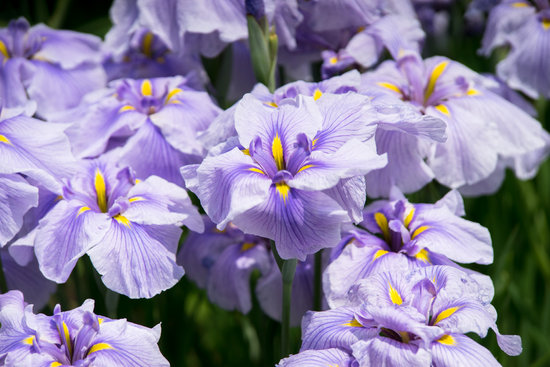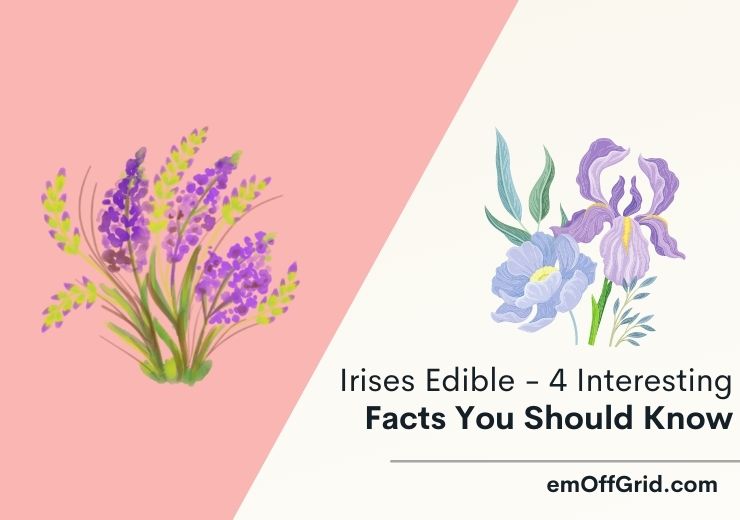Edible flowers are often used in many cuisines all over the world to add both a unique burst of flavor and elegant color to the dishes.
However, not all colorful flowers are edible, and the iris is one of them with little known facts to humans.
Just because you have seen some dishes garnished and decorated with edible flowers in restaurants doesn’t mean that you can use any and every flower to replicate the same at home.
There are many flowers that are toxic and using them without proper knowledge can be extremely dangerous.
In this article, we will discuss the Iris plant and try to gather all essential facts about this beautiful flower available in striking color variations.
Furthermore, our aim is to clarify if the Iris is an edible flower and does this flower has any other applications.
Contents
Irises & Editability?

Iris is an aesthetically pleasing flower that is named after the Greek goddess of the rainbow.
This name is given due to multiple color variants of this species. Each color of the iris flower has some symbolic meaning. For example,
- Purple irises signify admiration and wisdom.
- Blue color represents faith and hope.
- Yellow irises are said to symbolize passion.
- White color denotes purity.
From about 200 known species of iris, all of them are considered poisonous, right from the roots to the flowers.
The entire plant is toxic because it contains noxious compounds like irisin, irone, iridin, etc. Therefore, the iris is quite a dangerous herb. Therefore, you must take all necessary precautions while handling the plant.
Appearance and Habitat

Irises are perennial plants grown from rhizomes or bulbs (bulbous irises), which have long and erect stems. Rhizomatous irises bloom in the summer, whereas bulbous irises bloom late in the spring.
Irises grown from rhizomes can be of three types:
- Bearded: This is the most widely grown iris, and the name ‘Bearded Iris’, comes from the conspicuous ‘beard’ of white or colorful hairs in the middle of each fall (outer surrounding petals).
- Beardless: Beardless irises are primarily found in the Siberian, Japanese, Pacific Coast, and Louisiana. They have very smooth falls.
- Crested: It is a low-growing plant that typically grows about three to six inches tall. It has iris flowers that are light blue, lilac, or lavender with gold crests on the falls.
They can be identified by large, unobstructed ruffled blooms with three dangling outer sepals (falls) and three inner petals (standards).
Iris flowers are available in a wide range of colors, ranging from white to nearly black, with lavender, purple, white, and yellow being the most popular.
Although irises are considered to be a plant of the northern temperature zone, some of their most beautiful species are found in the Mediterranean and Central Asian regions.
Irises need at least half-day exposure to direct sunlight for proper growth.
Fun Fact: The Iris Garden in Florence, Italy, and the Presby Memorial Iris Garden in New Jersey are the world’s largest iris gardens.
Toxins and Symptoms Of Irises
Iris plants, whether wild or cultivated, are poisonous as the entire plant contains potentially toxic and irritating resinous compounds.
The toxin concentration is greatest in the rhizomes (underground stems) and bulbs, while the concentration is mild in the stems and flowers.
Iris poisoning can cause anything from mild gastrointestinal troubles to skin rashes or severe illness. Some of the common symptoms include:
- Skin Irritation
- Burning Sensation in Mouth/Throat
- Abdominal Pain
- Nausea
- Vomiting
- Diarrhea
- Fever
Note: According to ASPCA (American Society for the Prevention of Cruelty to Animals), rhizomes are the most toxic part of the iris plant.
Are Irises Poisonous To Pets/Animals?

The effect of iris toxicity is considered very mild in humans, however, it can cause serious illness in pets/animals, even to the extent of death.
This is because the iris contains a very high concentration of a number of toxic compounds like irisin, terpenoids, quinines, etc., which, when consumed by your pets, can be fatal.
The following symptoms in your animals indicate that they may be poisoned by iris:
- Drooling
- Vomiting
- Diarrhea
- Lethargy
Are Irises Poisonous To Dogs?
Yes, Irises are poisonous to dogs. If your dog chews or ingests even a small part of the iris, he may get extremely sick and need urgent veterinary care.
Symptoms of iris poisoning in dogs may develop immediately or take few hours depending on the quantity and portion of the iris eaten. Some of the symptoms include:
- Vomiting
- Drooling
- Diarrhea
- Lethargy
- Abdominal Pain
- Eye Irritation
- Skin Irritation
- Sores on Lips
Are Irises Poisonous To Cats?
Yes. Just like the dogs, irises are also poisonous for the cats. While iris poisoning in cats is usually mild to moderate, it may cause significant discomfort to your cat.
Some of the signs that your cat may be suffering from iris poisoning include:
- Nausea
- Abdominal Pain
- Diarrhea
- Vomiting
- Mouth Ulcers
- Skin Irritation
What Animal Eats Iris?
Even though the iris plant as a whole is considered toxic for both humans and animals, there are certain creatures that love to eat iris.
These creatures include rabbits, deer, ground squirrels, voles, moles, and insects like crickets, aphids, caterpillars, whiteflies, snails, slugs, spider mites, and moths.
It is the smell of irises that attract these animals towards the iris plants in the garden. Depending upon their preference, they like to eat different parts of the plant. For example:
- Rabbits enjoy almost any part of the plant that they can munch on.
- Moles primarily feed on roots and bulbs.
- Insects love to feed on the rhizomes.
- Voles prefer to feed on the seed and the seedlings.
- Ground squirrels love to eat almost every part of the iris.
Facts You Didn’t Know About Irises.

Iris is not just a colorful, vibrant, and attractive flower found in gardens, but it has several other uses, which makes iris plantation a commercial investment.
Although iris is poisonous, you made find its use in several commercial applications like perfumes, medicines, etc. Let us have a look at some lesser-known facts about the iris.
Medicinal Uses
Since ancient times, rhizomes from different iris species have been used in traditional medicine to cure a spectrum of diseases.
For example, Native Americans used the iris as a remedy for emetic (vomiting), cathartic, diuretic, and to treat wounds, earache, cold, and cholera.
Iris extract has also made its place in homeopathic medicines to treat thyroid and other conditions related to the pancreas, salivary and intestinal glands.
Many components extracted from different iris species have shown strong biological activity in recent research.
For example, the methanolic extracts of iris rhizomes have shown good inhibition against many bacterial strains.
Apart from the above-mentioned medicinal uses, iris essential oil is used in aromatherapy. In addition, iris essential oil has regenerative abilities and is used in nourishing skin and toning.
Aromatic Uses
Iris is known to be used commercially to produce a pleasant fragrance for perfumes, room fresheners, food essence, etc.
It is the roots of the iris plant that is used in the perfume industry to create exquisite fragrances.
Irises come in a variety of colors and sizes, however, not all of them have the same characteristic odor. Only the Pallida and the Germanica species of the iris are used for making perfumes.
The aroma of the iris is distilled and extracted from the dried roots of the plant.
After drying, the roots naturally develop a delicate powdery clean fragrance that is enhanced when they are ground into a powder.
Use In Water Purification
One of the species of iris known as yellow flag iris, yellow iris, or water iris, has been used for water treatments. This particular species of iris has the ability to purify water by removing heavy metals through its roots.
Water iris helps in absorbing excess mineral nutrients such as nitrogen and phosphates. They are also known for their use in wastewater treatment to capture toxins and control odor.
Fun Fact: The yellow flag iris is a native plant of Europe, Asia, and North Africa.
Culture Uses
Irises are named after Iris, the ancient Greek mythological goddess of the rainbow. This flower is also listed as the birth flower for the month of February.
In addition, according to cultural beliefs, the iris flower is also the 25th wedding anniversary flower.
Iris being one of the most beautiful and the most popular flowers in the State of Tennessee, attracted many visitors to the state and was later adopted as the state flower of Tennessee.
Iris is said to be the inspiration for the Fleur de Lis symbol by many scholars. The symbol is associated with the French monarchy, and it signifies royalty, power, honor, faith, and unity.
Reblooming Bearded Iris – 3 Large Rhizomes – Colorful Cocktail Mix
- PRODUCT: Includes 3 bulbs/rhizomes mix (Iris germanica Califlora 'Colorful Mix'). Images of flowers are for reference only.
- INFO: Hardiness Zones 3-10. Bearded Iris are incredibly easy to grow and the flowers attract butterflies and other pollinators.
- BRAND: Easy to Grow is an American company that partners with farmers and growers.
Final Thoughts
Although iris is known for its medicinal uses, you should avoid its direct treatment at home. This is because of the poisonous nature of the plant, which can be very dangerous if not handled correctly.
There are many other options for herbs that you can use instead of iris. Here is the list of 12 Plants You Can Eat For Offgrid Living. If you want to plant for yourself, here is our article about 26 Edible Plants To Grow Indoors.
As usual, thank you for choosing Emoffgrid.com as your reading source! I hope you will find the information in this post useful. Please feel free to share your views on the content of this post with us.

